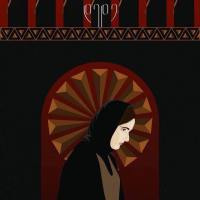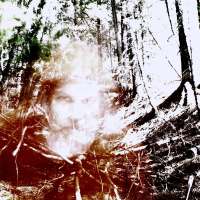The Beauty Of Shadows And Light

Fingers as Animals in Isn’t This A Lovely Day?
Light and dark. Illumination and shadow. These are the most primal elements of visual experience. Everything we see reflects this. Even colors are essentially shadow shows with degrees on a spectrum of light and how they are reflected back to us by different materials. But black and white is the key. And black and white are the primary images in shadow puppetry. And the most basic of all entertaining shadows is silhouette of the hand. Hands and figures are the elemental tools. The shadows cast upon a wall by a light source creating rabbits or birds or perhaps just the shape and personality of the human hand itself. Thus making the hand the original puppet. And from that simplicity comes the complex artistry of Budrugana Gagra in Tbilisi, Georgia.
‘Budrugana’ is a Georgian word that means a carriage, particularly the kind of carriage that might open up in a small village in the Caucasus Mountains and produce a puppet show. ‘Gagra’ is the name of a town now cordoned off from Georgia in the breakaway region of Abkhazia. There was strife in the 1990s in Abkhazia. There was bloodshed. There were refugees. Hundreds of thousands. Most of them were Mingrelian Georgians (or Megrels, მეგრელები Megrelebi). And they were housed in strange places, like the huge old Soviet Intourist Hotel, now the considerably more swanky Radisson Blu not far from Rustaveli Square.

With ‘Bidza’ Gela Kandelaki at Budrugana Gagra
Budrugana had existed as a hand shadow puppet theatre in a previous incarnation without the word Gagra attached to it. Gela Kandelaki (whose name actually means candle holder in church) a film director, producer, and actor once, wrote and directed უბედურება (Ubedureba) a very realistic film based on a play by David Kldiashvili. Directing work was not steady under the Soviet system. (Tarkovsky only directed 7 films in his fights with the authorities.) And so in the early ’80s Kandelaki came upon the idea of bringing the old art of hand shadows, which was still performed in small villages up in the mountains by parents for their children, into a new form. He created a unique shadow puppet troupe. Kandelaki began working as a director with hand shadows in the 1980s, which was a time of cultural ferment in the loosening grip of the faltering Soviet system. Interestingly enough they practiced in the basement of the Karlo Sulakauri’s house/museum. (See the previous essay.) Budrugana officially came into being in 1991 at the International Festival of Manipulations in Paris. In 1992 they were designated a ‘state theatre’. In 1993 they flew all the way to the International Puppetry Festival in San Francisco.
Meanwhile the situation in Georgia became more unstable as the 1990s continued. Civil War, separatist movements, financial collapse, political uncertainty, electrical failures, along with the growing internal refugee crisis, created a difficult moment for the arts. But as the dust began to settle in the roller coaster of the Georgian ’00s it seemed appropriate to Gela to start the hand shadow theatre again. There were many available Megrelebi with creative talents who needed something to do. Several of the shadow puppeteers are Megrelebi. And so the name Gagra was added to Budrugana as a tribute to the formerly beautiful resort town that was ethnically cleansed of its many Georgian residents.
So Budrugana Gagra under Gela Kandelaki’s directorship has been making hand shadow art for many years in one way or another. When I first noticed their work in 2016 I was impressed by the dedication that the hand shadow puppeteers have to their work. The motions are balletic, which Gela attributes less to any direct influence of dance than to the essence of certain aspects of Georgia folk culture. The movements of the hands are incredibly precise. And they have to be in order to communicate the shapes of animals or the much more subtle waves of the ocean. Kandelaki, who does not perform the actual hand shapes himself, works out the forms with the owners of the hands. And different hands have different suggestions of presence and movement. And these shapes often correspond to the character of the puppeteers. Zuri, with big hands will often play larger or move immovable objects. Shorena and Mariam have the most pliant and supple arms and are used more for the grace and delicacy of there movements. Elene plays the duck in one story and she is more humorous.

Giorgi’s Poster for Isn’t This A Lovely Day?
And there are essentially two styles that Budrugana Gagra works with. One is a more accessible comic style with hands making ravens, spiders, giraffes, elephants, ducks and above all bears. And the other is much more abstract and ethereal and often is set to the music of Bach. Most recently they have been working on a multi-part series of abstract vignettes to Bach’s Saint Matthew’s Passion. It will in the end have more than 15 sections and be performed to a recording, complete with orchestra and voices. Yet the way the work is unfolding it is by no means a literal transforming of the Gospel material into directly symbolic forms. There are no hand shadows making crosses for instance. And yet…
One thing has occurred to me as I have watched several performances. Even in the animal based images there is something going on beyond the obvious. In the piece ‘Isn’t This A Lovely Day?’ a hand shadow bear lip-syncs the words of Louis Armstrong from a live performance. (Sadly Louis Armstrong is probably better remembered in Georgia than in America. A live puppet film from back in the Soviet Era, called the Dreams of the Kojori Forest, also features a puppet of dear Louis.) Other animals play musical instruments. Another hand bear becomes the great Jazz singer Ella Fitzgerald. The Louis bear falls in love with the Ella bear and then loses her. In the end he dies. And the sad processional music of a New Orleans jazz funeral creates a moment of sorrow and tension. An angel takes him to heaven. But the joyful jazz marching music of the return journey from the cemetery brings him back in a resurrected form. It is not a simple nor ironic comedy. The Louis Armstrong bear is not a silly cartoon character of the great jazz musician. The disappearance of the Ella bear is a moment of genuine loss. (Louis and Ella never had any sort of romantic relationship in real life.) The death is truly sad. The resurrection genuinely joyful.
I asked Gela about the spiritual content of his work. The Saint Matthew’s Passion, though abstract, is loaded with suggestions of pilgrimage, prayer, deep beauty amidst struggle. He confessed in my interview with him that though he also said he was not always the most Christian man, something does come indeed through… I think he was being modest. His work has a depth that is quite hard to ignore. And the more I have spent time watching his unique shadow theatre the more I am inspired to push the boundaries of what can be said and felt through this medium. Especially in the realm of shadows and light.
Budrugana Gagra has in many ways been like a creative home for me here. I feel that I can drop in at any time. And even if the puppeteers present don’t speak English very well I always feel welcomed and accepted. Gela, who is in his late 70s, looks at me as ‘young’ visitor. At one point he told me told call him Bidza Gela, Uncle Gela. An honor indeed. Gela actually stopped me at one point when I mentioned that it my home away from home. He said “No! It’s just your home.” I had told him of what had happened in Alaska. (Click this to read that.) I replied “Then it’s my Georgian home.” He laughed and agreed with that. I will continue to visit my friends at Budrugana Gagra. They play about once a month in the ‘small room’ at the Rustaveli Theatre. If you ever come to Tbilisi, and I highly recommend that you do, then you must seek them out. (Links below.) And then you will understand the beauty and meaning of shadows and light.
Byrne Power
Tbilisi, Georgia
20 / 3 2018
And here is Budrugana Gagra’s website. Go visit them!
And you can read about my first visit with Budrugana Gagra here.
https://gravityfromabove.wordpress.com/2018/03/21/the-beauty-of-shadows-and-light/
PS. If you wish to contribute to Gravity From Above and our current journey then please feel free to give through PayPal. It is easy and safe. Several supporters have done so already. And their gifts have been truly timely beneficial. This kind of exploration is in no way a luxurious adventure. So yes do feel free to give.
Here is the link: Do it today when it would be most useful. And THANK YOU!
CLICK ME https://www.paypal.com/cgi-bin/webscr?cmd=_s-xclick&hosted_button_id=G9LDYMSPZ5RGG




















Pingback: Tojina Checkmate | GRAVITY FROM ABOVE
Pingback: Gravity From Above: A Personal Reckoning | GRAVITY FROM ABOVE